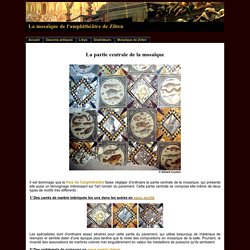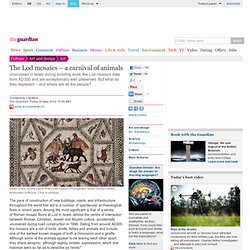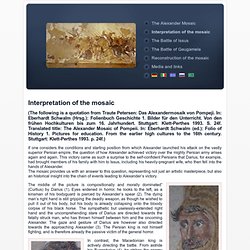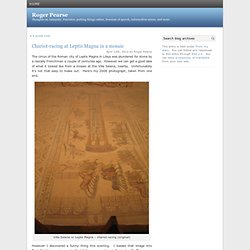

Roman mosaic patterns - A Visual Glossary – The Ancient Home. I know you like your compass drawn graffiti @MedievalG and I saw a lovely Medieval mosaic example today in Arezzo. Roman griffin mosaic, 6th-4th century BC. From the Great Palace Museum, Istanbul. (GraphicaArtis/Getty Images) Roman mosaic at the Domus Romana 1st century BC Roman house #archaeology Malta just outside Mdina & Rabat. LaunchPad: Ancient and Byzantine Mosaic Materials. La partie centrale de la mosaïque de Zliten. Il est dommage que la frise de l'amphithéâtre fasse négliger d'ordinaire la partie centrale de la mosaïque, qui présente elle aussi un témoignage intéressant sur l'art romain du pavement.

Cette partie centrale se compose elle-même de deux types de motifs très différents : 1/ Des carrés de marbre imbriqués les uns dans les autres en opus sectile Les spécialistes sont d'ordinaire assez sévères pour cette partie du pavement, qui utilise beaucoup de matériaux de réemploi et semble dater d'une époque plus tardive que le reste des compositions en mosaïque de la salle. Pourtant, la vivacité des associations de marbres colorés met singulièrement en valeur les médaillons de poissons qu'ils sertissent. The Lod mosaics – a carnival of animals. The pace of construction of new buildings, roads, and infrastructure throughout the world has led to a number of spectacular archaeological finds in recent years.

Among the most significant is that of a series of Roman mosaic floors at Lod in Israel, almost the centre of interaction between Roman, Christian, Jewish and Muslim culture, accidentally uncovered during road construction in 1996. Dating from around AD300, the mosaics are a riot of birds, shells, fishes and animals and include one of the earliest known images of both a rhinoceros and a giraffe. Although some of the animals appear to be tearing each other apart, they share seraphic, although slightly sinister, expressions, which one historian went so far as to describe as "erotic". The Lod mosaics were of such exceptional quality, and in such an excellent state of preservation, that it was decided, wisely, to rebury them until a plan had been formulated to secure their long-term future.
Interpretation of the Alexander Mosaic. (The following is a quotation from Traute Petersen: Das Alexandermosaik von Pompeji.

In: Eberhardt Schwalm (Hrsg.): Folienbuch Geschichte 1. Bilder für den Unterricht. Von den frühen Hochkulturen bis zum 16. Jahrhundert. Stuttgart: Klett-Perthes 1993. If one considers the conditions and starting position from which Alexander launched his attack on the vastly superior Persian empire, the question of how Alexander achieved victory over the mighty Persian army arises again and again. The middle of the picture is compositionally and morally dominated” (Curtius) by Darius (1).
In contrast, the Macedonian king is actively directing the battle. Also on account of the damage to the mosaic, there are few Macedonians – recognisable by their bonnet-shaped helmets – around Alexander The majority of the picture, almost three-quarters of the total surface, belongs to the Persians. La Mosaïque du calendrier agricole - Le destin tragique de Vienne (15 min) Cette vidéo a été créée dans le cadre d'un engagement pour l'égalité des chances avec l'Université de Paris X (Nanterre - département des Hauts-de-Seine) et l'INHA.

L'auteur du scénario est Véronique Vassal, jeune docteur en histoire de l'art et spécialiste des mosaïques (Université de Paris X -Nanterre). Elle a reçu le soutien du CED pour la dramatisation de l'oeuvre. Cette vidéo n'aurait pas été possible sans la contributions de nombreux partenaires. Outre nos grands partenaires, nous remercions particulièrement le directeur du Musée archéologique national, M.
Patrick Périn, ainsi que M. Tutorial: making the million tesserae Oceano mosaic (part1) Chariot-racing at Leptis Magna in a mosaic at Roger Pearse. April 12th, 2014 by Roger Pearse The circus of the Roman city of Leptis Magna in Libya was plundered for stone by a rascally Frenchman a couple of centuries ago.

However we can get a good idea of what it looked like from a mosaic at the Villa Selene, nearby. Unfortunately it’s not that easy to make out. Here’s my 2006 photograph, taken from one end. Villa Selene nr Leptis Magna – chariot racing (original) However I discovered a funny thing this evening. Villa Selene, chariot racers – autoleveled Suddenly we can see! Digital photography … it is such a gift!
La Mosaïque du calendrier agricole - Le destin tragique de Vienne (15 min) Interpretation of the Alexander Mosaic. La Mosaïque du calendrier agricole - Le destin tragique de Vienne (15 min) The Lod Mosaic: The Discovery of an Ancient Roman Mosaic. Laure Olive - Humbel / Néréides.